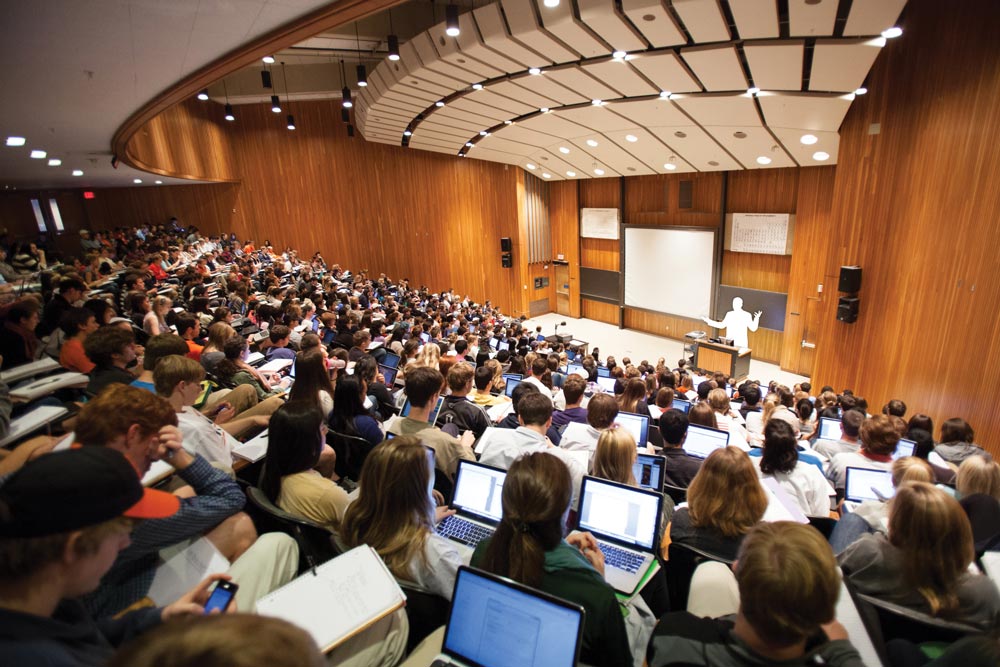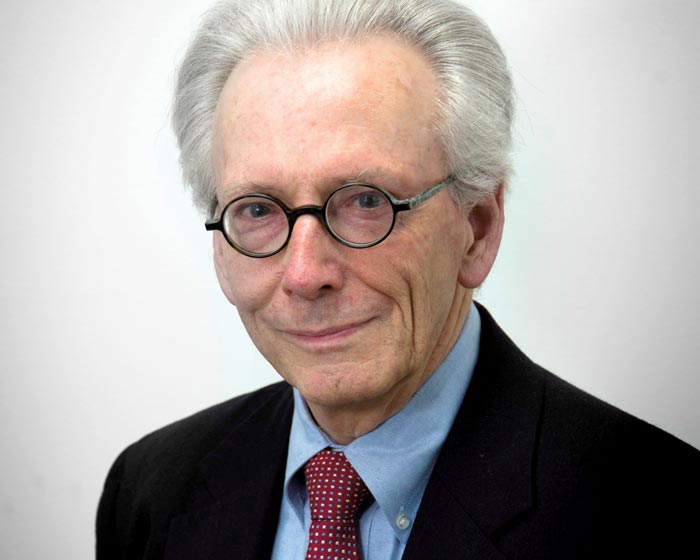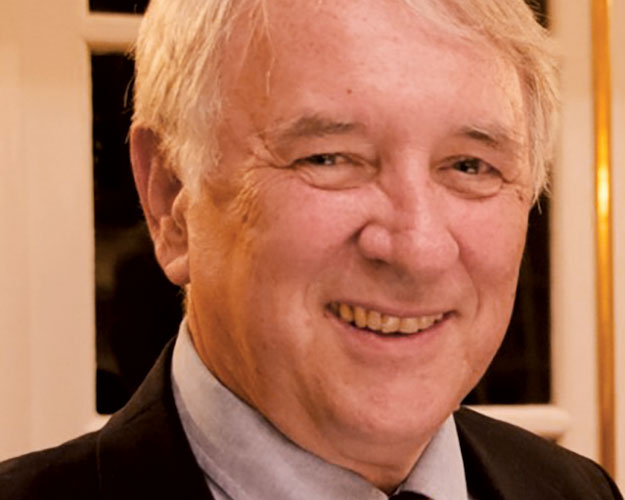Hire Ed
As hundreds of faculty near retirement, the University has a plan

In a career of nearly four decades here, James Childress—who came to the College as an assistant professor in religious studies—taught more than 19,000 students. He helped build the department, as well as overseeing the creation of the University’s first residential college.
In the tradition of UVA’s culture, Childress cultivated strong relationships with students, frequently having dinner with them and playing croquet with them in a small grassy area near the residential college.
Last May, he retired at the age of 75. A ceremony in Newcomb Hall paying homage to the former Thomas Jefferson Award winner—who also held appointments in the School of Medicine and Batten School—drew former students, colleagues and members of the administration, among them President Teresa Sullivan.
Childress is one of hundreds of tenured and tenure-track professors the University expects to replace in the next few years. According to Margaret Harden, associate vice provost for Academic Administration, about a sixth of the University’s tenured and tenure-track faculty members were 65 or older last fall—edging close to or past the average retirement age of 68. The Law School has the highest percentage of these older professors: 26.4 percent. Next highest are the nursing school and the College, at 23.1 percent and 21.9 percent, respectively.
In 2012, then-Provost John Simon sounded the call to the Board of Visitors: Up to 35 percent—more than one in three—of the 1,000 or so tenured and tenure-track faculty members around the University (excluding the School of Medicine, which has different types of appointments) will retire before 2020.
Replacing professors who have made such a mark is a challenge—and the way administrators go about that task figures to have long-term implications on the University and its makeup, as well as the unique culture of Grounds.
The University is not only seeking to replace retiring professors; it’s increasing the number of faculty overall, according to its five-year hiring plan. Virginia is now in the fourth year of that plan—a hiring “boom,” as Provost Tom Katsouleas calls it, that started in 2013—which aims to replace 300 professors who are leaving its undergraduate schools and hire 100 more by the end of 2018. Katsouleas and other UVA administrators have said they are making research and science a priority in their hiring and aim to hire faculty who can work across multiple disciplines. Another focus has been diversity.
Katsouleas and others have correlated this spate of retirements, and the attendant hiring need, to faculty growth in the 1970s, when UVA went coed. Headcount did grow around that time and has continued since, according to figures from UVA’s office of Institutional Assessment and Studies, but it’s difficult to show a direct relationship between then and now, at least in precise numerical terms.
“It is that bolus of faculty from that period that is at retirement age,” Katsouleas says in an email. “Thus the percentage of our faculty expected to turn over in the coming period is higher than most peers.”
Simon, the former UVA provost who is now president at Lehigh University, says he believes many schools are in a predicament similar to UVA’s because of the combination of coeducation and student population growth during the ’70s. “Everyone’s dealing with this to some degree,” he says.
Interestingly, the University of North Carolina, which also experienced growth around coeducation in the 1970s, is not seeing a similar retirement rush, according to Executive Vice Provost Ron Strauss. After the passage of Title IX in 1972, UNC’s student population began to grow, which led to more faculty hiring, he says. While some of those hires are near retirement age, Strauss says, he isn’t anticipating increased turnover. “We have a reasonable age spread across our faculty, and it does not seem to be happening in a wave, rather, more gradually,” he says in an email.
Sullivan, Katsouleas and other administrators have said in speeches that they’re using these hiring opportunities to, in part, diversify both the faculty and the scope of the curriculum.
At the beginning of the five-year hiring plan, in fall 2013, women represented 24 percent of tenured faculty at the University, and nonwhite faculty made up 14 percent. According to Katsouleas, 41 percent of the new tenured and tenure-track hires made last year were women, and 31 percent were underrepresented minorities, including nine African-American professors. The University won’t know the impact the hiring has made on overall diversity until after the fall census, Harden says.
“This was the most diverse new class of faculty ever,” says President Sullivan.
One new curricular concentration in the College is the Global South Initiative. In the past year and a half, the College has hired six full-time professors for courses and research that focus on the connected histories and cultures of Africa, Latin America, South and East Asia, and other world regions. Within the next two years it hopes to hire four more, according to Francesca Fiorani, associate dean for the arts and humanities. Fiorani says the types of themes being explored in the initiative, such as race and migration, require faculty who can work in and with multiple disciplines. She says the cost of the new hires is being covered, in part, by a $3.47 million Mellon Foundation grant, with plans for the University to eventually absorb it into the long-term budget.
Two newer hiring strategies also allow the University flexibility in reshaping its faculty: “cluster” and “target of opportunity” hires.
In cluster hiring, administrators identify an area of important scholarship spanning disciplines and schools, and then seek faculty members in that area. Clusters can range from one to seven professors. Searches often result in joint appointments in more than one school or department. One recent example: Economist Sally Hudson, who is known for her work in education policy, was hired as part of a cluster between the Curry and Batten schools.
The University has also made cluster hires in neuroscience and traumatic brain injury. “The idea is that the best way to build strength in an interdisciplinary field like the brain and neuroscience is to bring together the top talent and best minds from departments that touch on that across the University,” Katsouleas says.
Katsouleas says the first year of cluster hiring was a learning experience—his main takeaway being that the clusters need to be bigger.
“We had a lot of clusters that were only two faculty members as opposed to six or seven,” Katsouleas says. “The deans’ feedback was that they’d rather have fewer clusters approved and have them at the full complement.”
A target of opportunity hire, known as a TOPs hire, gives the University a way to recruit a “superstar” faculty member—even if there is no search under way in that field. According to University administrators, the most notable recent TOPs hire was Jayakrishna Ambati, a leading researcher in macular degeneration.
But will a hiring boom that seeks to replace 300 undergraduate tenured faculty in just five years bring with it unintended consequences? Will the unique culture of UVA—including the Honor System—shift and change?
“You risk losing some of the cultural aspects of the institution,” says Simon, who himself came to UVA from Duke in 2011, “because people don’t have role models and they don’t have sort of the infrastructure around them to have them become part of what the community values. You risk that.”
Childress, for one, says he doesn’t believe an influx of newcomers will have much of an effect on the Honor System. He says faculty participation in the system has always varied anyway. Childress recalls turning a student in for plagiarism in his second year at UVA, only to have the student’s peers not take any action. In the end, Childress says, he simply failed the student.
“There’s been debate among the faculty since I arrived as to how well the system works,” he says.
Corinne Thomas, who chairs the Honor System’s Faculty Advisory Committee, says professor buy-in to the system is crucial. “Most reports we see come from faculty. They don’t come from other students. In that way, faculty are an integral part of the system.”
Katsouleas says measures are in place to educate the new recruits with the touchstones of UVA culture, such as the Honor System and close faculty-to-student interactions. Embracing the Honor System is noted as a requirement in offer letters to prospective faculty. Soon after they arrive, they participate in a two-day orientation that includes sessions on Honor, among other topics. In addition, students have recently developed a program on UVA’s culture of self-governance, a basic principle of the Honor System, for new faculty.
“I think there’s always a concern that culture will be lost,” says Childress, “but I’m confident that this place has significant values and positive virtues—and that people who come in will want to maintain what really makes an institution work.”








